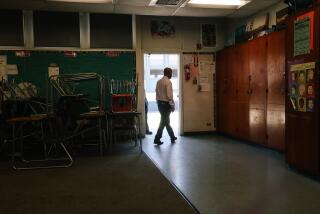Innovative Schools to Receive Grants
- Share via
At a time when California’s recession-plagued economy has inflicted budget-cutting miseries on every part of its public education system, some of the state’s most innovative schools soon will get money to try out their reform ideas.
The first installments of a $100-million state grant program will arrive with the new year at 138 schools, Bill Honig, state superintendent of public instruction, said Wednesday. The money, earmarked by 1990 school reform legislation, will cover everything from new math lessons to changes in the way a school is run.
“Many of our public schools already have developed comprehensive reform plans,” Honig said as he toured Will Rogers Elementary School in Santa Monica, one of 29 schools in Los Angeles County to receive a grant. “They’ve shown great commitment and innovation during a very difficult time, and they’ve shown us you don’t need an expensive private effort to do it.”
The more than 800 elementary and secondary schools applying for the grants were required to demonstrate how they would overhaul themselves to improve achievement for all students, make learning more relevant and engaging, and use technology to enhance learning. They needed to broaden parental and community involvement in their campuses and provide ways for teachers to build on their skills and work together. They also had to set goals for improvement and tell how they intended to measure their progress.
Each school’s proposal was tailored to fit its students’ needs. Will Rogers plans to use some of the $500,000 it will receive over the five-year life of the grant to expand on recent innovations. A longer school day for students needing extra attention, more use of computers and the conversion of the library into a comprehensive media center have been high on everyone’s list, said Principal Juli DiChiro.
DiChiro looks at the grant as “part of an ongoing process of self-improvement” that will culminate in the school’s transformation into a “learning community” formed of staff, parents and civic groups.
The families who send their children to Will Rogers, in the working-class Ocean Park neighborhood, represent a broad mix of racial backgrounds and income levels. Spanish is the first language of about half the school’s 670 students.
The school’s reform efforts have centered on finding ways to boost the achievement of every child. In math classes, children are required to explain in writing how they arrived at their answers. Time is set aside weekly for teachers to work together planning lessons and thrashing out issues. A special program is designed to iron out reading difficulties before they undercut a child’s self-esteem and interest in learning.
Key decisions are made by the school “congress” of parents and staff, with the help of small “cadres” of other parents and community members. Maria Leon Vasquez, the mother of a second-grader, said the system has resulted in better opportunities for Spanish-speaking children and their parents to participate in school life.
Honig said Will Rogers is just one good example of “a quality school in public education,” in which everyone works together to find ways to improve.
At least half of the 822 schools that applied for the state grants had worthy proposals, Honig added. But state officials did not want to spread the money too thinly.
The reform legislation, approved almost three years ago with the support of the California Business Roundtable, will provide $11.6 million this school year and $23 million in each of the next four years.
That is not a huge amount for cash-starved school districts forced by the state’s budget problems to cut back on school nurses, increase class sizes and slash jobs or salaries, Honig conceded.
But, he said, schools such as Will Rogers “show what a big difference even a little discretionary money can make when you have everybody focused and pulling together.”
Reform Grants for Schools
These schools received five-year grants to pay for some of their education reform proposals.
Los Angeles County
ABC Unified
Tracy High
Azusa Unified
Lee Elementary
Dalton Elementary
Charter Oak Unified
Glen Oak Elementary
Claremont Unified
Sycamore Elementary
Culver City Unified
Culver City High
East Whittier City Elementary
Orchard Dale
Lancaster Elementary
Joshua Elementary
Long Beach Unified
Jordan High
Washington Middle School
Los Angeles Unified
Montague Street Elementary
Vaughn Street Elementary
Woodlawn Avenue Elementary
John Muir Junior High
James A. Foshay Junior High
Olive Vista Middle
Montebello Unified
Garfield Elementary
Norwalk-La Mirada Unified
Walnut Elementary
Gardenhill Elementary
Paramount Unified
Paramount High
Los Cerritos Elementary
Pasadena Unified
Blair High
Pasadena High
Woodrow Wilson Middle
Pomona Unified
Garey High
Kellog Polytechnic Elementary
Santa Monica-Malibu Unified
Will Rogers Elementary
Torrance Unified
Torrance High
Compton Unified
Compton High
More to Read
Sign up for Essential California
The most important California stories and recommendations in your inbox every morning.
You may occasionally receive promotional content from the Los Angeles Times.











